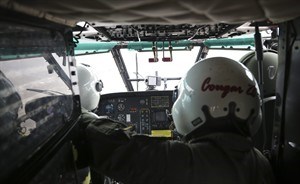
Crew members of an Indonesian Air Force Super Puma helicopter looks out a window during a search operation for the crashed AirAsia Flight 8501 over the Java Sea, Indonesia,Saturday, Jan. 17. 2015. National Search and Rescue Agency chief Henry Bambang Soelistyo said Friday, that rescue teams discovered more wreckage despite the strong current and poor visibility. (AP Photo/Achmad Ibrahim, Pool)
January 17, 2015 - 5:43 AM
PANGKALAN BUN, Indonesia - High waves and strong currents in the Java Sea again prevented Indonesian navy divers from accessing the fuselage and what is believed to be the cockpit from the AirAsia plane that crashed three weeks ago, officials said.
A team of 15 navy divers tried to get to the wreckage to examine it and calculate its weight, but failed to reach it due to the unfavourable conditions, said Suryadi Bambang Supriyadi, director of operations for Indonesia's National Search and Rescue Agency.
Indonesian survey ships have located at least nine big objects, including the jet's fuselage, what is believed to be the cockpit and an engine, Supriyadi said. The fuselage is sitting on the seabed at a depth of 28 metres (92 feet).
The 30-meter-long (100-foot-long) fuselage and an attached wing were sighted Wednesday. Divers attempted to reach the wreckage Thursday and Friday, but were turned back because of the rough sea conditions.
Authorities believe many of the bodies are still inside the fuselage. There were 162 people aboard Flight 8501 when it crashed into the sea Dec. 28 en route from Surabaya, Indonesia's second-largest city, to Singapore. Only 51 bodies have been recovered so far.
The head of the search and rescue agency, Henry Bambang Soelistyo, said Friday that the fuselage would have to be lifted because of the divers' inability to reach it. This will be done by either using floating balloons, as the tail section was lifted earlier in the week, or cranes from tugboats. Soelistyo did not say when the operation would start.
Divers, however, still need to reach the wreckage area. The wreckage that appears to be the cockpit was located by sonar imagery about 500 metres (yards) from the fuselage and was partly embedded in the mud.
"What we have so far is only a silhouette of the wreckage," Supriyadi said. "We need to deploy our divers to identify whether it's the jet's cockpit or something else."
He also said the divers have been told to retrieve the bodies of the pilot and the co-pilot if they are able to find them in the cockpit.
Bad weather is a suspected factor in the crash. The plane's flight data and cockpit voice recorders were retrieved earlier in the week and will be key to learning the cause.
News from © The Associated Press, 2015